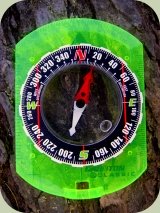How to Read a Compass

Understanding how to read a compass properly is a vital outdoor skill. Using a compass is a fundamental way to help you determine your location and direction of travel. It is also important to understand what a compass does and what it does not do.
How to Read a Compass:
Compass Parts
Though there are many types of compasses on the market, here are some primary components that are part of most compasses:
The Compass Body or Housing: This houses the movable parts of the compass.
Direction-of-travel Arrow: An arrow painted on outside the compass that you can use to aid in directional travel.
Orienting Arrow: A fixed arrow usually painted underneath the movable parts of the compass.
Compass Needle: The movable part of the compass that follows the earth's magnetic pull.
True North versus Magnetic North
There are two types of North, and understanding this is vital in knowing how to read a compass. True North is located at the North Pole, which is the point in the Arctic Sea around which the earth rotates.
The Magnetic North, however, is located in a different location, in northern Canada. This location actually changes with time.
The earth is covered in magnetic lines that come out of the Magnetic South, cover the planet, and converge again at the Magnetic North. To understand Magnetic North, you need to understand that in most parts of the country those magnetic lines point pretty far from True North. That variance between the True North and Magnetic North is called magnetic variation or declination.
When you are learning how to read a compass, you must take this variance (declination) into account. This variance is given as a number in units of degrees, based on the 360 degrees in a circle. Depending on where in the northern hemisphere you live, this number might be east or west of True North. Many modern compasses have declination readings printed near True North on them to help. Modern topographic maps include the declination number on them. You can also visit NOAA's Geophysical Data Center online to learn what the declination is for your area.
Find out what declination is for your area and keep this number with you. You might even want to write a note on a piece of paper and leave it inside your compass container or write it directly on your compass. Remember to check it at least every few years, as it can change with time.
Using a Compass in the Field
Look carefully at your compass, and make sure there are no metal or
magnetic objects near it when you do (they can skew your compass
readings). Place the compass so that North is at the top of the circle.
Now use the numbers of declination and rotate the compass slowly until
you are the correct number of degrees away from the magnetic North to
point to True North. Remember that North on a map is calibrated to True
North. So when using your compass along with a map, remember to adjust
for the declination or difference.
Be More Prepared For Your Next Outdoor Adventure!

Don't leave home without knowing these six essential survival skills. Our free survival mini guide reveals the strategies of:
- Shelter & fire to prevent the number one cause of death
- Obtaining clean water to avoid life-threatening dehydration
- Common wild survival foods and other critical skills!

Taking a Compass Bearing
One way to help you learn how to read a compass is to play a simple
game of taking compass bearings of objects in your surrounding area. A
compass bearing is the number of degrees between an object and the north
on your compass. Try this by standing with your compass in your palm at
about waist height. Now, point the fixed direction-of-travel arrow at
an object or landmark. Then, twist the compass housing so the compass
needle lies right over the orienting arrow. Make sure that the compass
needle is pointing North at the top of the housing. Finally, read the
number on the rim of the compass. That is the bearing of the landmark –
the number of degrees it is from Magnetic North.
For more practice or assistance in learning how to read a compass, you can check out a navigation book from the library or visit with a local orienteering club.
By the way, if you enjoyed this article then you'll love our survival mini guide. You'll discover six key strategies to staying alive in the outdoors plus often-overlooked survival tips. We're currently giving away free copies here.
Related Courses
Wilderness Survival Courses at Alderleaf

About the Author: Filip Tkaczyk is a periodic guest teacher at Alderleaf. He also wrote the field guide Tracks & Sign of Reptiles & Amphibians. Learn more about Filip Tkaczyk.
Return from How to Read a Compass back to Survival Articles
Is The Essential Wilderness Survival Skills Course Right for You? Take the "Online Survival Training Readiness" Quiz
See for yourself if this eye-opening course is a good fit for you. It takes just a few minutes! Get your Survival Training Readiness Score Now!

Grow Your Outdoor Skills! Get monthly updates on new wilderness skills, upcoming courses, and special opportunities. Join the free Alderleaf eNews and as a welcome gift you'll get a copy of our Mini Survival Guide.

 The Six Keys to Survival: Get a free copy of our survival mini-guide and monthly tips!
The Six Keys to Survival: Get a free copy of our survival mini-guide and monthly tips!
Learn more